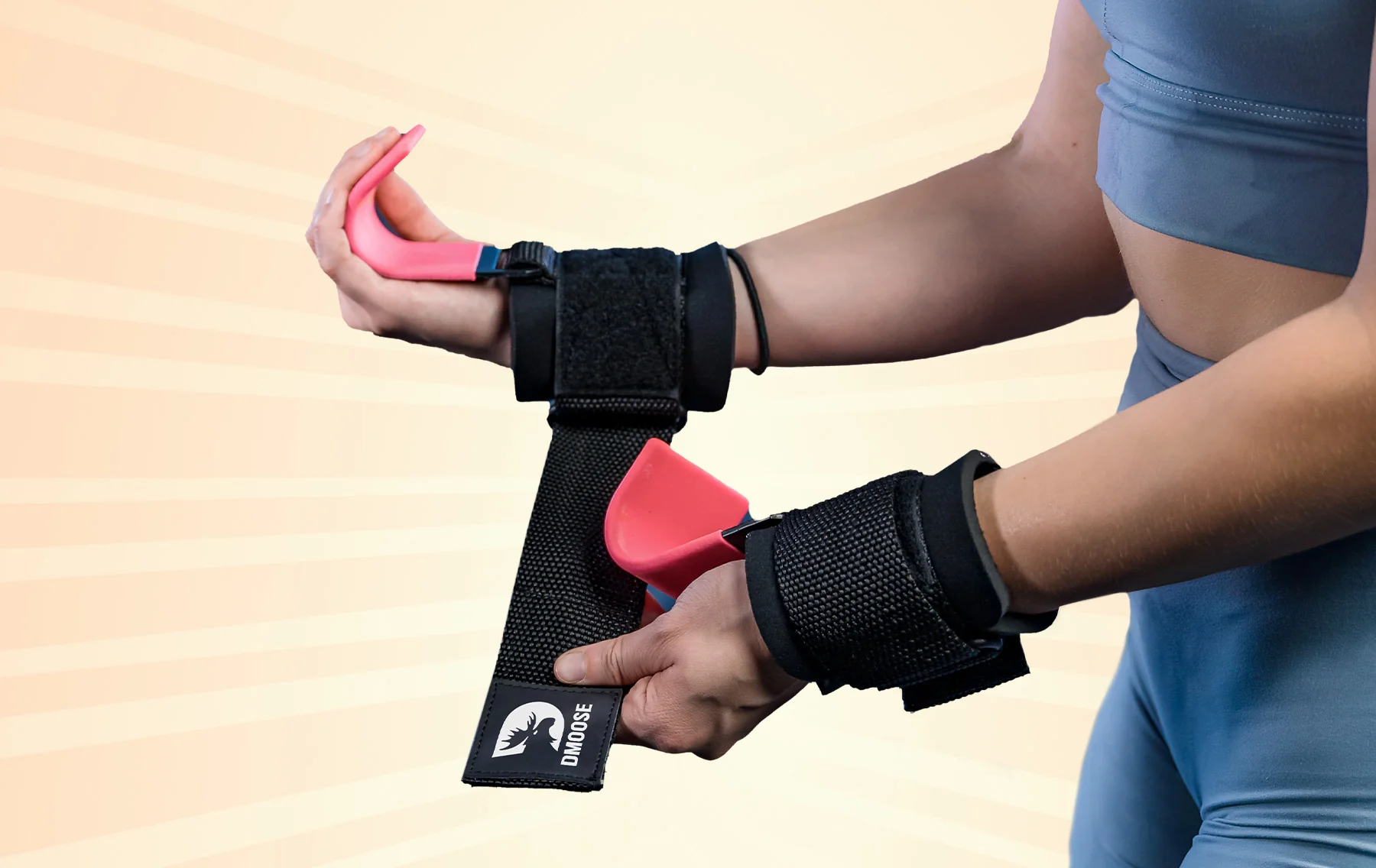Ever feel like your grip strength might be the only thing holding you back from hitting that new personal best in the weight room? You're not alone. Many fitness enthusiasts find that their grip becomes the limiting factor in their lifts as they progress to heavier weights. That's where weight lifting hooks come in. These handy tools are designed to support your grip and help you lift heavier weights more comfortably.
But you might have questions—like do weightlifting hooks work, who should use them, and are weightlifting hooks any good besides others?
We've got you covered with answers to the most frequently asked questions about weight lifting hooks, helping you decide if they're the right addition to your gym bag.
What is a Lifting Hook Used for?

A lifting hook is a specialized piece of fitness equipment designed to enhance your grip and reduce the strain on your hands and forearms during heavy lifting sessions. Research says that these hooks are used primarily for weightlifting exercises, including deadlifts, shrugs, and rows, where grip strength often becomes a limiting factor.
Beyond just helping with grip, lifting hooks can aid in training efficiency. They allow you to focus more on the target muscle groups rather than worrying about your hands slipping. This can lead to better muscle isolation and quicker strength gains.
Additionally, for those recovering from or dealing with hand and forearm injuries, lifting hooks can be a valuable tool to maintain intensity in workouts without aggravating the injury.
Do Lifting Hooks Work?
Absolutely. The heavy duty lifting hooks consist of a sturdy metal hook attached to a strap that wraps around your wrist. A study revealed that when you perform a lift, the hook bears some of the weight, allowing you to handle heavier loads than your grip alone might support.
This not only helps in improving your performance by enabling you to lift more weight but also reduces the risk of grip fatigue and failure. This can be especially beneficial during high-volume workouts or when targeting muscle groups that require lifting heavy weights.
Are Weightlifting Hooks Any Good?

Weightlifting hooks can be incredibly beneficial for certain lifters, depending on their goals, strength levels, and any pre-existing conditions they might have.
Here’s a breakdown of the advantages and potential drawbacks to help you decide if they're a good fit for your workout regimen:
Advantages of Weightlifting Hooks
Enhanced Grip Support
Weightlifting hooks take some of the load off your grip, allowing you to handle heavier weights or perform more reps than you might otherwise be able to manage.
This can be particularly useful during exercises like deadlifts and shrugs, where grip strength can be a limiting factor.
Reduced Forearm Fatigue
By alleviating some of the strain on your grip, hooks can help reduce forearm fatigue. This allows you to concentrate on the primary muscles targeted by the exercise, potentially leading to better gains in muscle strength and size.
Injury Prevention and Management
For those with weak grips or recovering from hand, wrist, or forearm injuries, weightlifting hooks can allow continued training without further strain.
They provide a way to lift safely, maintaining workout intensity without risking new injuries or exacerbating old ones.
Focus on Target Muscles
Hooks can help you focus more on the target muscle groups by stabilizing your grip. This isolation can lead to more effective workouts as you're able to perform movements more precisely.
Potential Drawbacks
Overreliance
There's a risk of becoming too reliant on hooks, which can lead to underdevelopment in grip strength and forearm muscles. It’s important to use them as a tool rather than a crutch, integrating grip-strengthening exercises into your routine as well.
Improper Form
Incorrect use of hooks can lead to poor form, particularly if they encourage you to lift more weight than you can safely handle. This can increase the risk of injury, particularly to the back and shoulders.
Not Suitable for All Exercises
Weightlifting hooks are not beneficial for every type of lift. They are typically used for pulls and deadlifts but might be less effective or inappropriate for other exercises like bench presses or snatches.
Weightlifting hooks are good for those looking to push their limits in specific lifting exercises without being held back by grip strength. They can also be a strategic addition for those dealing with injuries. However, it's crucial to use them wisely to avoid creating imbalances or fostering reliance that could hamper overall development and performance.
How to Use Weightlifting Hooks
Using weightlifting hooks correctly is essential for maximizing their benefits while minimizing the risk of injury. Here’s a step-by-step guide on how to use weightlifting hooks effectively:
Step 1: Choose the Right Hooks
Ensure that the hooks you choose are suitable for your weightlifting needs. They should be made of durable materials and capable of withstanding the weights you plan to lift. The strap should also be comfortable and secure around your wrist.
Step 2: Adjust the Straps
Before you start lifting, adjust the straps of the hooks to fit snugly around your wrists. The strap should be tight enough to stay in place during your lift but not so tight that it cuts off circulation or feels uncomfortable.
Step 3: Position the Hooks
Slip your hands through the straps so that the hooks rest in the palm of your hands. Position the metal hooks over the barbell or dumbbell. Ensure that the hook grips the bar securely. For most exercises, the hook should be underneath the bar, curving around it.
Step 4: Grip the Bar
While the hooks take on some of the weight, it’s important to still grip the bar. This helps maintain control of the lift and ensures your hands are active in supporting the weight, which aids in maintaining proper lifting technique.
Step 5: Perform the Exercise
With the hooks in place and a firm grip on the bar, you’re ready to perform your exercise. Whether it’s deadlifts, shrugs, or rows, ensure you maintain proper form throughout each movement. The hooks should support your grip but not completely take over the lift—keep your hands engaged.
Step 6: Release Carefully
Once you’ve completed your set, carefully release the bar. Be mindful of how you unload the weight, as the hooks can make the release slightly different from what you might be used to without them. It’s crucial to control the weight to avoid sudden drops or mishaps.
Important Tips for Using Weight Lifting Hooks

Follow these tips to make the best use of your heavy duty weight lifting hooks:
- Begin with lighter weights to get used to the feel of the hooks and ensure proper technique.
- Use hooks to enhance your grip, but continue to focus on maintaining good form throughout your lifts.
- Wrist hooks for lifting are most beneficial for pull movements like deadlifts, rows, and pull-ups. Use them specifically for these exercises to maximize their benefits.
- While hooks can improve your grip strength, ensure you also work on developing your natural grip to prevent imbalances.
- Inspect your hooks regularly for any wear and tear to ensure they remain safe and effective for use.
What are the Best Lifting Hooks?

Among multiple options, the Weight Lifting Hooks from DMoose are the best weight lifting hooks.
These hooks are crafted to enhance your grip and reduce hand fatigue, enabling you to lift heavier weights with confidence. With a robust construction that can handle up to 500 lbs and a comforta
With a robust construction that can handle up to 500 lbs and a comfortable, secure fit, these hooks are perfect for a wide range of exercises, from deadlifts to rows.
Key Features Include:
Anti-Slip Grip: High-quality rubber coating ensures a secure hold on the bar, preventing slippage during intense lifts.
Ultimate Comfort: Thick neoprene padding on the wrist straps provides superior support and comfort, reducing wrist strain during heavy lifts.
Extreme Strength: Capable of handling up to 500 lbs, these hooks are built for heavy lifting without compromise.
Rust-Resistant: Zinc-coated buckle enhances durability, preventing rust and ensuring long-lasting performance.
Versatile Design: Ideal for a variety of exercises, including deadlifts, shrugs, and rows, enhancing your gym experience.
Multiple Color Options: Available in different colors, these hooks can be a cool gym accessory that matches your gym wear.
Weightlifting Hooks vs. Straps: Which Should I Use?

When choosing between weightlifting hooks and straps, consider your specific needs and goals.
Weightlifting hooks are ideal for those who experience grip fatigue quickly or have hand/wrist issues, as they provide extra support and allow you to lift heavier weights. They're great for exercises like deadlifts and rows. Weightlifting straps, however, offer a more natural feel and are versatile for various exercises. They help improve grip strength and are preferred by experienced lifters for high-rep sets and pulling movements.
Many lifters benefit from having both in their gym bag, using each tool as needed to enhance their performance.
Related Article: Lifting Straps Vs. Hooks – Which One Should I Choose for Heavy Lifts
Can You Use Weight Lifting Hooks for Pull Ups?
Yes, you can use weight lifting hooks for pull-ups, though they are not typically necessary or beneficial for everyone. Weight lifting hooks can be useful for pull-ups if you have grip issues or are recovering from a hand injury, as they help in transferring some of the load away from the fingers and palms, reducing grip fatigue.
This allows you to focus more on engaging the muscles in your back and arms. However, using hooks can also limit the natural development of grip strength that comes from performing pull-ups unassisted.
The Bottom Line
Weight lifting hooks are amazing for those looking to enhance their lifting capabilities, especially when grip strength is a limiting factor. They not only assist in handling heavier weights with more ease but also help in focusing on target muscle groups effectively, reducing the risk of grip fatigue and injuries.
Whether you're a seasoned lifter facing plateaus or a beginner needing extra support, incorporating wrist hooks for lifting into your routine can offer significant benefits. Ready to level up your gym sessions? Check out DMoose Weight Lifting Hooks for the best lifting experience and see the difference for yourself!
Reading List
How to Choose the Best Barbell for Your Weightlifting Needs
Lifting Hooks 101 — A Beginner's Guide to Supercharge Your Workouts
Maximize Your Lifts | Learn How to Properly Use Knee Wraps for Powerlifting
Bodyweight Vs. Weightlifting: Which Is Better for Muscle Building?
Bodyweight Vs. Weightlifting: Which Is Better for Muscle Building?
Article Sources
- Oranchuk, Dustin J., et al. “Improved Power Clean Performance with the Hook-Grip Is Not Due to Altered Force-Time or Horizontal Bar-Path Characteristics.” Journal of Sports Sciences, vol. 40, no. 2, Jan. 2022, pp. 226–35. PubMed, https://doi.org/10.1080/02640414.2021.1986270.
- Trahey, Kevin M., et al. “The Effect of Lifting Straps on Deadlift Performance in Females.” Journal of Strength and Conditioning Research, vol. 37, no. 10, Oct. 2023, pp. 1924–28. DOI.org (Crossref), https://doi.org/10.1519/JSC.0000000000004494.



















